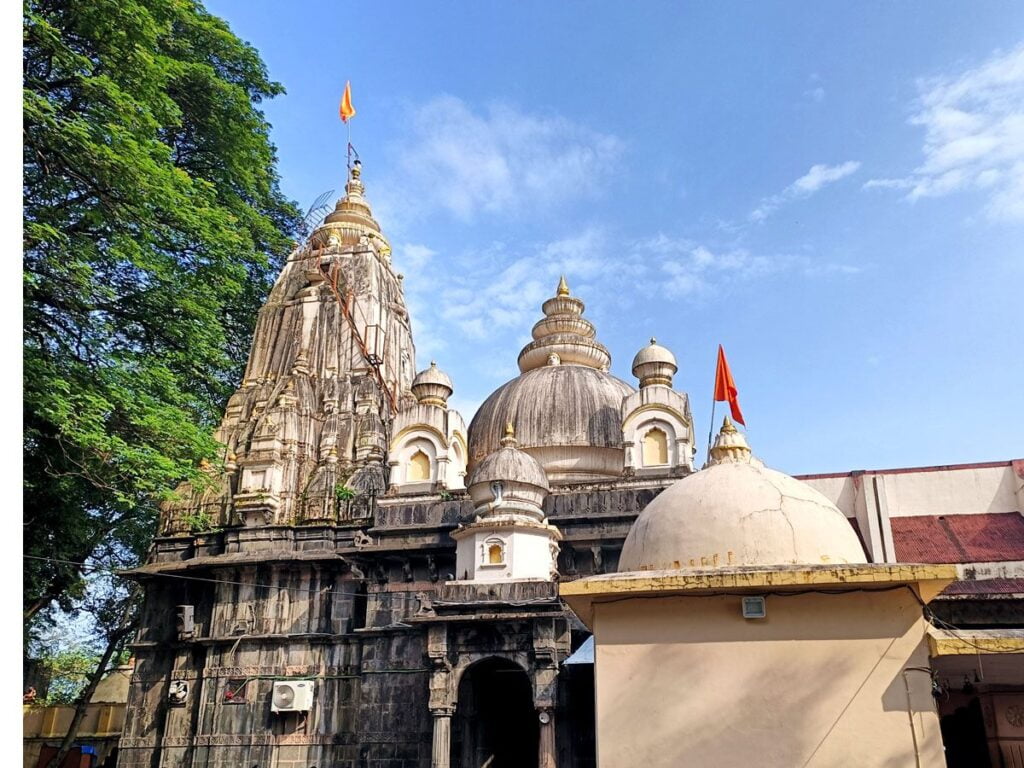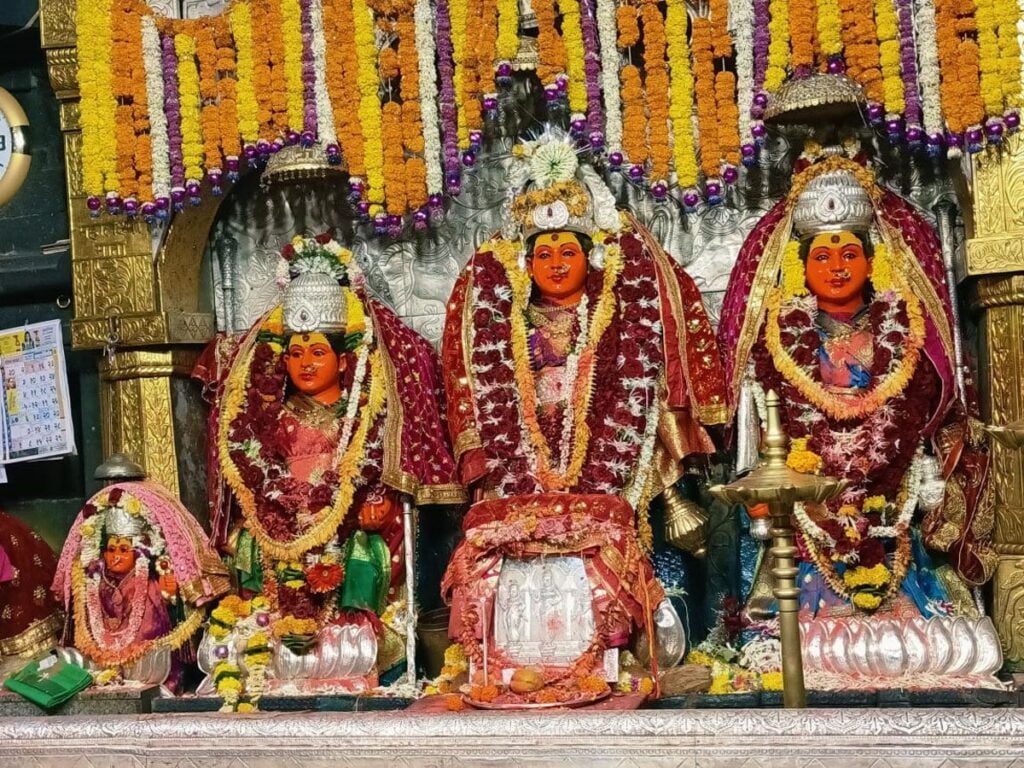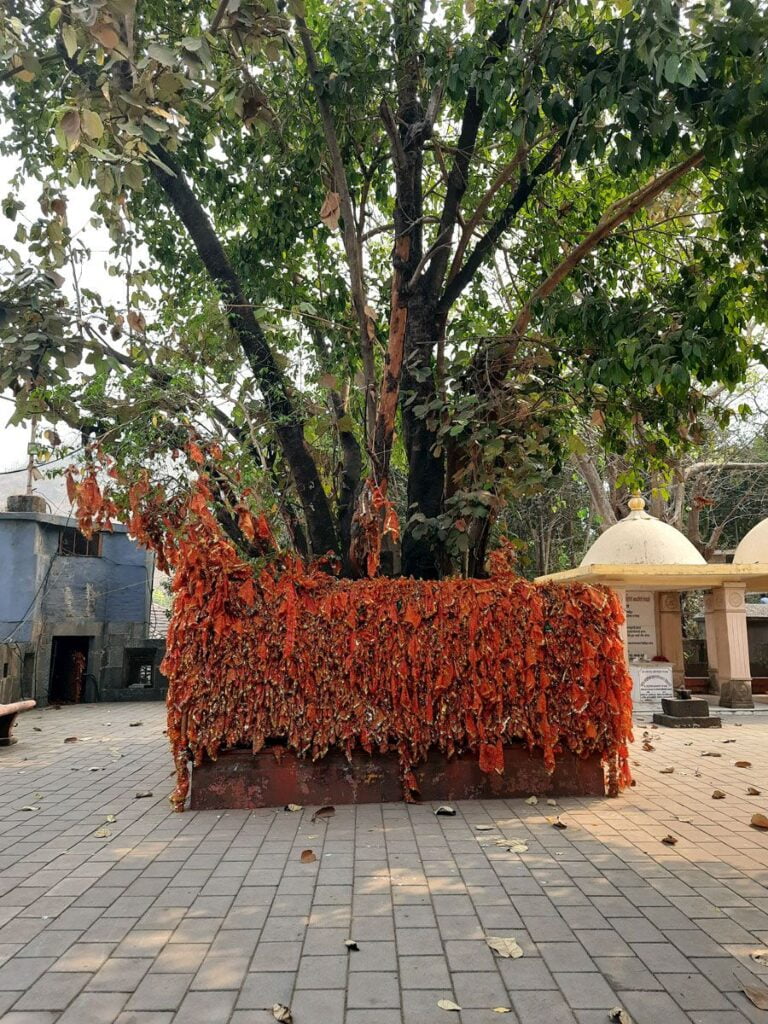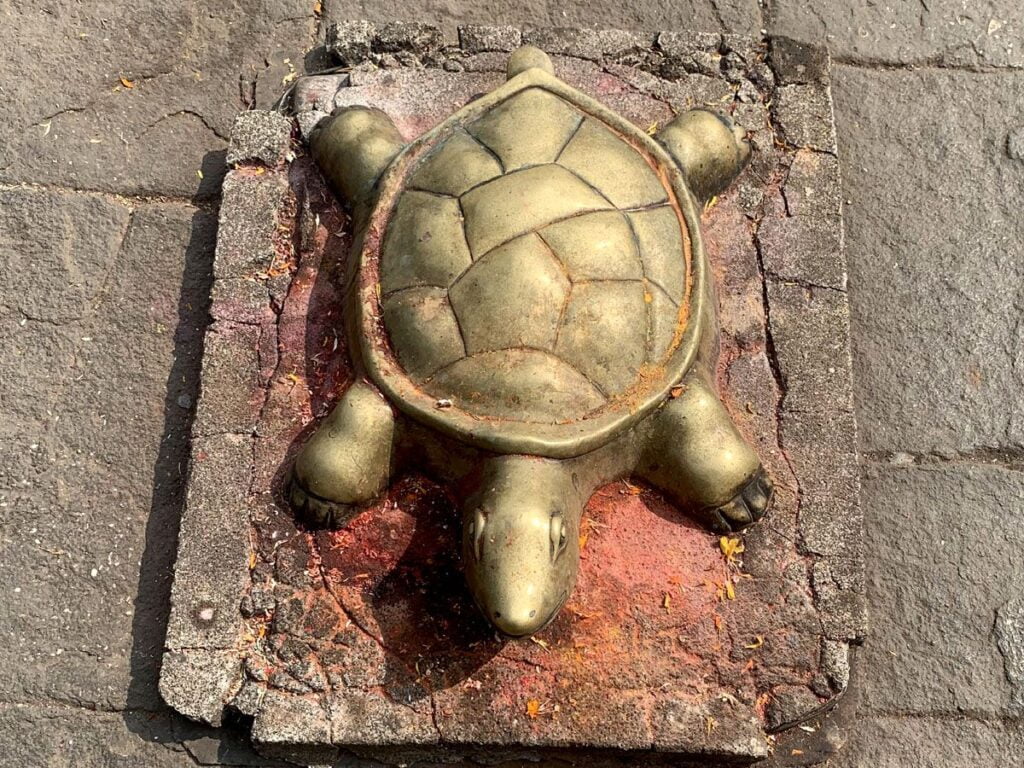Vajreshwari Temple Maharashtra
The Shree Vajreshwari Yogini Devi Mandir, also known as the Vajreshwari Temple, is a Hindu temple dedicated to the goddess Vajreshwari, located in the town of Vajreshwari, Maharashtra, India. It is about 75 kilometers away from Mumbai.

Contents
- 1 Vajreshwari Temple History:
- 2 Legend of Vajreshwari Temple:
- 3 Significance of Vajreshwari Temple:
- 4 Myths of Vajreshwari Temple:
- 5 Architecture of Vajreshwari Temple:
- 6 Vajreshwari Temple Timing and Rituals:
- 7 Places to visit near Vajreshwari Temple:
- 8 FAQ:
- 8.0.1 1. Who is Goddess Vajreshwari?
- 8.0.2 2. Where is Vajreshwari Temple located?
- 8.0.3 3. What are the timings of the temple?
- 8.0.4 4. Is there an entry fee?
- 8.0.5 5. What is the significance of Vajreshwari Temple?
- 8.0.6 6. What is the best time to visit the temple?
- 8.0.7 7. What should I wear to the temple?
- 8.0.8 8. What can I do at the temple?
- 8.0.9 9. How can I reach the temple?
- 8.0.10 10. Are there any accommodation options near the temple?
- 8.0.11 11. What are the benefits of Vajreshwari hot springs?
- 9 How to reach Vajreshwari Temple:
- 10 Google Maps:
Vajreshwari Temple History:
Ancient Beginnings:
While the current temple structure dates back to the 18th century, the origin of Vajreshwari’s worship stretches further back in time. Legends narrate that an ancient temple stood in Gunj, around 8 kilometers north of the present location. This early iteration is believed to have existed during the Pandava era, with carvings of Parshuram, Renuka, and Bhagirathi still standing as silent witnesses to times gone by.
The Peshwa Legacy:
However, the most prominent chapter in the temple’s history unfolds during the Maratha reign. In 1739, Chimaji Appa, the younger brother of Peshwa Baji Rao I, faced an insurmountable challenge – conquering the Portuguese-held Bassein Fort. After three years of unsuccessful attempts, he sought divine intervention at the ancient Vajreshwari temple in Gunj. Legend has it that the goddess appeared to him in a dream, promising victory if he built a new temple in her honor at Vadvali, the present location.
True to his word, Chimaji Appa, upon conquering the fort in 1739, commissioned the construction of the magnificent temple we see today. The existing temple in Gunj was later moved to Vadvali, which was subsequently renamed Vajreshwari in honor of the presiding deity.
Architectural Splendor:
Shree Vajreshwari Yogini Devi Mandir complex presents a harmonious blend of traditional Hindu architecture and Portuguese influences. The intricate carving on the black stone pillars and arches reflects the artistry of the era. The sanctum sanctorum houses a captivating idol of Goddess Vajreshwari, adorned with a silver nose ring and a golden crown. The temple complex also encompasses smaller shrines dedicated to Lord Ganesha, Lord Hanuman, and Lord Shiva.
Beyond History:
The Vajreshwari Temple transcends its historical significance to serve as a vibrant spiritual center for devotees. The temple celebrates two Navratri festivals annually, drawing throngs of devotees seeking blessings and participating in vibrant rituals. The annual fair held on Amavasya in the month of Chaitra is another major event, marked by illuminations and joyous festivities.
The seven sacred hot springs located near the temple further enhance its spiritual aura. Believed to possess therapeutic properties, these springs attract devotees seeking physical and mental well-being.
A Legacy Endures:
The Vajreshwari Temple stands as a testament to faith, devotion, and architectural prowess. Its story, interwoven with legend and historical fact, resonates with pilgrims and history buffs alike. As devotees continue to offer prayers and seek solace within its walls, the legacy of the Vajreshwari Temple promises to endure for generations to come.
Read More>> Kalaram Temple Nashik

Legend of Vajreshwari Temple:
1. The Wrath of Indra and the Rise of Vajreshwari:
- In this legend, a sage named Vashistha performed a sacred yajna (fire ritual). Enraged by the yajna’s power, the king of gods, Indra, hurled his vajra (lightning bolt) to disrupt it.
- Terrified, the gods and sages pleaded with Goddess Parvati for help. Heeding their prayers, Parvati manifested as Vajreshwari, meaning “Lady of the Vajra.”
- With unparalleled might, Vajreshwari swallowed the vajra, humbling Indra and vanquishing the demons threatening the yajna. Impressed by her valor, Rama requested Vajreshwari to reside in Vadvali, the Shree Vajreshwari Yogini Devi Mandir location.
2. Chimaji Appa’s Triumph and the Temple’s Promise:
- This legend unfolds during the Maratha Empire. Chimaji Appa, brother of Peshwa Baji Rao I, faced an arduous task: conquering the Portuguese-held Bassein Fort.
- After three years of unsuccessful attempts, a desperate Chimaji Appa sought blessings at the Vajreshwari Temple in Gunj (its original location). He vowed to build a new temple in Vadvali if he achieved victory.
- Legend has it that Vajreshwari appeared to Chimaji Appa in a dream, revealing a strategic plan to conquer the fort. Following her divine guidance, Chimaji Appa captured Bassein Fort on May 16, 1739.
- True to his promise, Chimaji Appa commissioned the construction of the present Vajreshwari Temple in Vadvali, solidifying her connection to the region’s history and military prowess.
Read More>> 12th Century Babulnath Temple Mumbai

Significance of Vajreshwari Temple:
Religious Significance:
- Dedicated to Goddess Vajreshwari: The temple is dedicated to the fierce aspect of Goddess Parvati, known as Vajreshwari. Her name translates to “lady of the vajra,” signifying her power and ability to conquer evil. Devotees believe that she fulfills wishes, protects from harm, and grants boons.
- Pilgrimage Site: The temple is a renowned pilgrimage site for Hindus, especially those seeking blessings for prosperity, good health, and success.
- Festivals and Rituals: Several festivals and rituals are celebrated throughout the year, with the most prominent being Navratri and Gudi Padwa. During these times, the temple bustles with devotees performing pujas and seeking darshan of the goddess.
Historical Significance:
- Ancient Origins: Though the current Shree Vajreshwari Yogini Devi Mandir structure dates back to the 18th century, the deity has been worshipped here for much longer. Legends mention the temple’s presence even during the reign of Pandavas in the Mahabharata era.
- Peshwa Legacy: The Peshwas, Maratha rulers, played a crucial role in the temple’s construction and patronage. They rebuilt the temple after it was damaged by the Portuguese and renamed the town of Vadvali to Vajreshwari in honor of the deity.
Cultural Significance:
- Architectural Marvel: The temple boasts a unique architectural style, blending elements of Hindu and Portuguese architecture. The black stone idol of Goddess Vajreshwari further adds to its mystique.
- Peaceful Atmosphere: Situated atop a hillock overlooking the Tansa River, the temple offers a serene and picturesque setting for prayer and meditation.
- Local Traditions: The temple is deeply integrated into the lives of the local community. Devotees often offer flowers, coconuts, and sweets to the goddess, and many consider visiting the temple a significant part of their cultural tradition.
Read More>> Mahabaleshwar Temple Maharashtra: 1200 yrs Sacred Atmalinga

Myths of Vajreshwari Temple:
1. The Tamer of the Thunderbolt:
One legend narrates the tale of a fire sacrifice (yagna) performed by the sages and gods, led by Vashishta. The mighty Indra, enraged by a denied offering, hurled his divine weapon, the Vajra, at the sacred ceremony. Just as chaos threatened to engulf the gathering, a divine being emerged. This goddess, with celestial grace, swallowed the Vajra, earning the epithet “Vajreshwari,” meaning “the lady of the Vajra.” Pleased with her intervention, the gods and sages implored her to reside in the region, and thus, the Vajreshwari temple was established.
2. Slayer of Demons:
Another myth speaks of a fearsome demon named Kalikala who terrorized the land. The gods, desperate for salvation, sought the aid of Parvati. The benevolent goddess assured them of her intervention and manifested as Vajreshwari in all her fiery might. A fierce battle ensued, and Vajreshwari, with her celestial weapons and unwavering resolve, vanquished the demon, restoring peace and tranquility to the region.
3. The Boon to Rama:
The epic Ramayana also finds its echoes in the temple’s lore. Legend has it that during their exile, Rama and Lakshmana sought refuge in the Vajreshwari caves. Impressed by the goddess’s power, Rama requested her to remain a protector of the land. Vajreshwari granted his wish, promising to forever shower her blessings upon the devotees who sought her grace.
4. The Sacred Springs:
The hot springs that bubble near the Shree Vajreshwari Yogini Devi Mandir hold their own mythical significance. Some believe them to be the blood of the demons slain by Vajreshwari, forever simmering as a testament to her victory. Others attribute their origin to the celestial touch of the goddess herself. Regardless of their source, these springs are considered to possess healing properties, drawing pilgrims from far and wide seeking physical and spiritual solace.
5. The Whispering Caves:
The caves nestled within the temple complex harbor an intriguing legend. It is said that these caves whisper ancient secrets and divine wisdom to those who listen with a pure heart. Devotees often spend hours in quiet contemplation within the caves, seeking guidance and answers from the whispers of the divine.
Read More>> Saptashrungi Bhadrakali Temple Nasik

Architecture of Vajreshwari Temple:
The Shri Vajreshwari Yogini Devi Temple, dedicated to Goddess Vajreshwari, is a stunning example of Maratha architecture, showcasing intricate carvings, vibrant colors, and a harmonious blend of religious and cultural significance. Here’s a closer look at its architectural highlights:
Exterior:
- Hilltop Setting: Nestled atop a small hillock in the Mandagiri mountains, the temple itself becomes a visual landmark, offering breathtaking views of the surrounding landscape.
- Fortress-like Walls: Enclosed by a sturdy stone wall, Shree Vajreshwari Yogini Devi Mandir evokes a sense of security and protection. The wall also features intricate carvings and decorative arches.
- Fifty-two Steps: Climbing the fifty-two steps to the main shrine symbolizes a spiritual journey, each step representing a different virtue or quality.
- Golden Tortoise: Carved onto one of the steps is a golden tortoise, representing Kurma, the tortoise incarnation of Lord Vishnu. Devotees often offer prayers and touch the carving for blessings.
Main Shrine:
- Tripartite Structure: The main shrine comprises three sections: the innermost sanctum (Garbha Griha), another sanctum, and a pillared mandapa (assembly hall).
- Six Idols: The Garbha Griha houses six idols, including the central saffron murti of Goddess Vajreshwari, depicted with a sword, mace, and trident.
- Mandapa: The assembly hall features a bell that devotees ring upon entering and a marble lion, believed to be the goddess’ mount. A Yajna kunda (fire offering structure) is also located here.
Read More>> Shree Ganesh Temple Ganpatipule
Vajreshwari Temple Timing and Rituals:
Timings:
- The Vajreshwari Temple is open from 5:30 AM to 9:00 PM on all days of the week.
Rituals:
- Morning Aarti: The first aarti of the day is performed at 5:30 AM.
- Second Aarti: The second aarti of the day is performed at 11:15 AM.
- Naivedya: Naivedya (offering of food to the Goddess) is performed between 11:30 AM and 12:00 PM.
- Evening Ritual (Paadha Pooja): The evening ritual is performed at 7:00 PM.
- Evening Aarti: The evening aarti is performed at 8:15 PM.
- Final Ritual and Temple Closed: The temple closes at 9:00 PM.
Read More>> Trikut Ganesh Temple Nanded
Places to visit near Vajreshwari Temple:
- Tansa Dam: Tansa Dam is located around 20 kilometers from Vajreshwari. It’s a picturesque location with a reservoir, making it a peaceful place to visit.
- Kelva Beach: Kelva Beach is approximately 30 kilometers away from Vajreshwari. It’s a popular beach destination where you can relax by the sea, enjoy the sunset, and take part in various beach activities.
- Shitlakhet: Shitlakhet is a village known for its natural beauty, and it’s about 35 kilometers from Vajreshwari. The place offers stunning views of the surrounding hills and landscapes.
- Jawhar: Jawhar is a hill station located around 40 kilometers away from Vajreshwari. It is known for its vibrant Warli paintings, tribal culture, and the majestic Jai Vilas Palace.
- Ganeshpuri: Ganeshpuri is about 10 kilometers from Vajreshwari and is known for the Bhimeshwar Mahadev Temple and the Nityanand Mandir. It’s a spiritual destination with a tranquil atmosphere.
- Saputara: Saputara, a hill station in the Dang district of Gujarat, is approximately 80 kilometers away from Vajreshwari. It offers lush green landscapes, the Saputara Lake, and the beautiful Sunrise and Sunset Points.
- Vasai Fort: Vasai Fort, also known as the Bassein Fort, is around 40 kilometers from Vajreshwari. It’s a historic fort with Portuguese and Maratha influences, offering a glimpse into the region’s colonial past.
- Kelva Fort: Kelva Fort is located near Kelva Beach, around 30 kilometers from Vajreshwari. It’s a historic fort with a scenic location overlooking the Arabian Sea.
FAQ:
1. Who is Goddess Vajreshwari?
Goddess Vajreshwari is an incarnation of Goddess Parvati, known for her power and strength. She is particularly worshipped for granting wishes related to health, wealth, happiness, and success.
2. Where is Vajreshwari Temple located?
Vajreshwari Temple is located on a hillock near Vasai in the Palghar district of Maharashtra, India.
3. What are the timings of the temple?
The temple is open from 5 am to 9 pm on all days of the week.
4. Is there an entry fee?
No, there is no entry fee to visit the temple. However, you may have to pay a nominal fee if you want to perform any rituals or offerings.
5. What is the significance of Vajreshwari Temple?
The temple is significant for several reasons:
- Ancient and historical: It is one of the most ancient temples in Palghar, with its origins believed to date back to the 10th century.
- Religious importance: It is a major pilgrimage center for Hindus, especially devotees of Goddess Vajreshwari.
- Architectural beauty: The temple boasts beautiful architecture with intricate carvings and sculptures.
- Scenic surroundings: Located on a hillock near a river, the temple offers stunning views and a peaceful atmosphere.
- Hot springs: Nearby, you can find seven hot springs believed to have therapeutic properties.
6. What is the best time to visit the temple?
The best time to visit the temple is during the morning or evening hours, as it can get quite hot during the afternoon. The monsoon season (June to September) also offers a pleasant experience with lush greenery and scenic waterfalls.
7. What should I wear to the temple?
It is recommended to dress modestly and respectfully when visiting the temple. Avoid wearing shorts, sleeveless clothes, or revealing outfits.
8. What can I do at the temple?
- Offer prayers to Goddess Vajreshwari.
- Participate in religious ceremonies and rituals.
- Enjoy the scenic beauty and peaceful atmosphere.
- Visit the nearby hot springs.
- Explore the surrounding areas like Vasai Fort and Pelhar Dam.
9. How can I reach the temple?
Vajreshwari Temple is easily accessible by road from Mumbai and other nearby cities. You can take a local train, bus, or taxi to reach Vasai and then hire a rickshaw or taxi to the temple.
10. Are there any accommodation options near the temple?
There are several hotels and guesthouses available in Vasai, offering budget-friendly to luxurious accommodations. You can also find camping grounds and resorts near the temple for a more immersive experience.
11. What are the benefits of Vajreshwari hot springs?
Vajreshwari hot springs are renowned for their potential benefits, both physical and spiritual. Here’s a breakdown of the pros and cons you might want to consider:
Potential benefits:
- Relief from pain and inflammation: The mineral-rich water, particularly sulfur, is believed to ease pain associated with conditions like arthritis, rheumatism, and muscle soreness.
- Skin conditions: Bathing in the springs is thought to be beneficial for various skin conditions like eczema, psoriasis, and acne due to the sulfur’s antibacterial and exfoliating properties.
- Improved blood circulation: The warm water can dilate blood vessels, potentially leading to better circulation and promoting relaxation.
- Stress relief: The immersive experience of bathing in a natural hot spring surrounded by nature can be incredibly calming and stress-reducing.
- Spiritual significance: For many, bathing in the springs holds religious and spiritual significance, believed to cleanse the soul and wash away negativity.
Things to consider:
- Limited scientific evidence: While anecdotal evidence suggests benefits, scientific research regarding the effectiveness of hot springs for specific ailments is limited. Consulting a doctor before visiting is always advisable.
- High mineral content: The mineral-rich water, while potentially beneficial, may irritate sensitive skin. It’s crucial to shower with fresh water after bathing in the springs.
- Hygiene: The cleanliness of the springs can vary depending on the specific location and individual maintenance. It’s important to assess the surrounding hygiene before entering the water.
- Safety: Be aware of the potential risks associated with hot springs, including overheating, dehydration, and burns. Avoid spending excessive time in the water, especially with pre-existing medical conditions.
How to reach Vajreshwari Temple:
By Air: The nearest airport is Chhatrapati Shivaji Maharaj International Airport (BOM) in Mumbai. From the airport, you can hire a taxi or take a bus to reach Vajreshwari. The temple is approximately 65-70 kilometers away from the airport, and the journey may take around 2 to 3 hours depending on traffic.
By Train: The nearest railway station to Vajreshwari is the Vasai Road Railway Station. From the railway station, you can hire a taxi or take a bus to reach the temple. The distance is approximately 35-40 kilometers, and the journey may take around 1 to 1.5 hours depending on the mode of transportation and traffic.
By Road:
- From Mumbai: Vajreshwari is approximately 80 kilometers away from Mumbai. You can take the Western Express Highway and then continue on the NH48 (Mumbai – Nashik Highway). After reaching Bhiwandi, take the Bhiwandi Bypass Road and follow the signs to Vajreshwari.
- From Thane: Vajreshwari is around 50 kilometers from Thane. You can take the Eastern Express Highway and then connect to the NH48. Follow the directions to Bhiwandi and then take the Bhiwandi Bypass Road to reach Vajreshwari.
